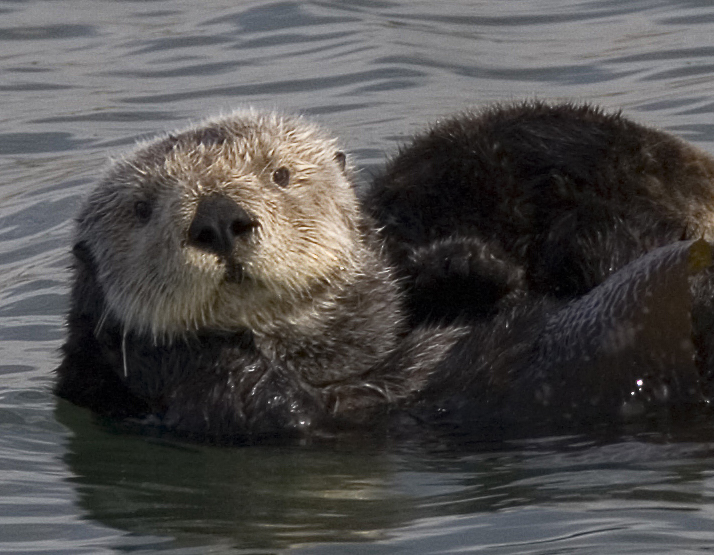
By Jeremy Geist
How can sea otters spend most of their life in the frigid ocean without lowering their body temperature? Their dense, waterproof fur holds the key. Read on to learn about the science behind the fluff.
Sea otter fur has two layers, according to Marianne Riedman in her 1990 book Sea Otters. The first is made of long, waterproof outer “guard hairs”; the second is the undercoat, which in some areas on an otter’s body can contain up to a million hairs per square inch. In fact, the sea otter’s fur, according to Stefani Paine in the 1993 book The World of the Sea Otter, is the densest of any animal on Earth. This dense underfur traps air bubbles and keeps the otter buoyant and its skin dry, writes Riedman. The longer guard hairs, which lay flat while underwater, create a seal that protects the undercoat.
Because an otter generally lives in water 40 to 65 degrees (Fahrenheit) colder than its internal body temperature, according to Riedman, maintaining the seal created by the guard hairs is critical for survival. Thus, grooming is an essential part of an otter’s day. Experts at the Aquarium of the Pacific report that a sea otter spends a total of about two and a half hours a day grooming, taking advantage of its loose skin and flexible skeleton to reach every section of its fur.
To groom, according to the Shedd Aquarium, an otter combs out its coat with its claws, squeezes the water out of its underfur, and then blows into it to create air bubbles. Lana Vanagasem, sea otter trainer at the Shedd, describes otters as making a “phhhh, phhhh” noise while aerating their coats. You can watch a video of an otter grooming here. During grooming, oils from the sebaceous glands adjacent to their hair follicles coat their fur, notes Thomas D. Williams and co-researchers in a 1992 paper in Marine Mammal Science. The study goes on to mention that otters’ hair oils contain a large amount of squalene, a substance that aids in the water repellancy of the otter’s fur.
Mother sea otters have the responsibility of grooming their babies. Paine writes that as soon as a sea otter is born, its mother grooms it immediately to make sure the infant’s fur doesn’t become waterlogged. In captivity, notes the Shedd, human caretakers often have to partially assist rescued babies in their grooming efforts.
This unique system of maintaining body heat has unfortunately put otters in danger multiple times. From the 18thcentury to 1911, sea otters were hunted to near-extinction for their thick, warm pelts, mentions Riedman, and in modern times otters find themselves especially vulnerable to oil pollution. A 1981 study by Daniel P. Costa and Gerald L. Kooyman found that, once exposed to oil, a sea otter’s fur loses much of its insulating ability for up to a week after the oil is removed. Special care must be taken to protect sea otters and their habitats from oil contamination.
If you liked this post, you can read more about sea otters in this one.
References
Aquarium of the Pacific. “Southern Sea Otter”. Web. Accessed May 29, 2018.
Costa, Daniel P. and Kooyman, Gerald L. 1982. Oxygen Consumption, Thermoregulation, and the Effect of Fur Oiling and Washing on the Sea Otter, Enhydra lutris. Canadian Journal of Zoology No. 60: 2761-2767.
Furnweger, Karen. 2012. “A Day in the Life of Shedd’s Sea Otter Pup: Grooming”. Shedd Aquarium. Web. Accessed November 30, 2018.
Paine, Stephani, and Jeff Foott. 1995. The World of the Sea Otter. Sierra Club, San Francisco.
Riedman, Marianne. 1997. Sea Otters. Monterey Bay Aquarium, Monterey.
Williams, Thomas D., et al. 1992. An Analysis of California Sea Otter (Enhydra lutris) Pelage and Integument. Marine Mammal Science No. 8: 1-18.